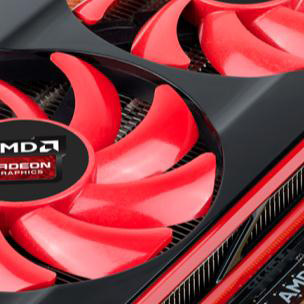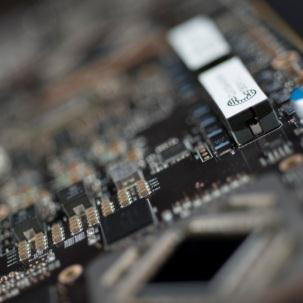AMD Teases Official Radeon HD 7990
by Ryan Smith on March 29, 2013 8:00 AM EST- Posted in
- GPUs
- AMD
- Radeon HD 7000
- Tahiti

Continuing our AMD GDC 2013 coverage, the other bit of major AMD news coming out of GDC 2013 involves a consumer product after all. But not strictly as a product announcement. Rather this is more of a product tease coming out of AMD. That tease? The Radeon HD 7990.
Since the latter half of 2012, AMD partners such as PowerColor and Asus have been offering what we’ve been calling “officially unofficial” Radeon HD 7990 cards. Officially, AMD doesn’t have a 7990 SKU, but at the same time AMD will approve multi-GPU Tahiti designs, and bless them with the right to be called a 7990. So officially the 7990 doesn’t exist yet, and yet unofficially it’s been offered for months now.
With that in mind, the 7990 will be moving from officially unofficial status to just outright official status. Ending their GDC presentation, AMD’s final item was a tease of their official Radeon HD 7990 design, with word that it’s coming soon. Real soon in fact, as we later found out DICE had been using some of these 7990 cards to power their Battlefield 4 demo elsewhere at GDC.
As this is a teaser AMD isn’t saying anything about the card beyond the fact that it’s a dual Tahiti card just as the unofficially official 7990s were. But even from the few pictures they’ve strategically provided we can infer a few things.

First and foremost, it’s a complete open-air cooler. AMD’s previous dual-GPU cards have all employed some kind of blower; up through the 300W 5970 they were full blowers, and the 375W 6990 was a split blower. Open air coolers have generally high performance, but they do require a breezy case since they’re not very capable of pushing hot air out on their own. The design essentially punts cooling off to the case, which is not always a bad thing since this affords much larger – and thereby slower and quieter – cooling fans.


Second of all, we can see something about the power delivery system. Two 8pin PCIe connectors are visible, which would put power at or under 375W. AMD has always shipped their cards with the proper connectivity to pull their rated power at stock, so as long as they’re holding to that this puts an upper-limit on where the 7990’s TDP would be at stock. This would be notably lower than the unofficial cards, which are closer to 500W (though admittedly also designed for liberal overclocking). Meanwhile we can also just see the edge of the VRM circuitry; the Volterra ‘C’ is visible on the edge of what appears to be a Volterra multi-phase inductor. Volterra is widely considered to offer some of the best VRM circuitry in the industry, and has been found on previous generation AMD dual-GPU cards.
In any case, we’ll be following this up as AMD releases more information. The fact that an official 7990 is appearing now makes it hard to argue that AMD isn’t late to the party – we’re coming up on a full year since the GeForce GTX 690 – but with AMD keeping Tahiti through Q4 there’s really no reason not to do it. So we’ll have to see just what AMD comes up with, and how their design differs from the unofficial cards that have come before it.










19 Comments
View All Comments
jko831 - Friday, March 29, 2013 - link
I mean the heat sink design. The S10000 is 2 7950s.jko831 - Friday, March 29, 2013 - link
Of course, AMD only specified two 7900 series GPUs...HisDivineOrder - Friday, March 29, 2013 - link
Looks like this is connected to having large numbers of the card they're using for their GRID-like products, so why not go ahead and release a consumer version, too?silentplummet - Friday, March 29, 2013 - link
1) AMD is sticking with their 7000 series branding for Sea Islands desktop parts.2) There aren't too many numbers after 7990, folks.
I feel it is safe to deduce from the above that there will be no high performance Sea Islands desktop SKUs to compete with Southern Islands on the high end. My wallet's going back in my desk.
aTonyAtlaw - Tuesday, April 2, 2013 - link
Are you kidding?!? There's room for at least 9 more graphics cards in the 799x series!manued08 - Monday, April 1, 2013 - link
I would prefer that Nvidia and AMD launch a new series of video cards like each 5 years, to improve quality, and give a good product, not a defective card, whit bad drivers. The games also be good optimized for that series of cards.tipoo - Tuesday, April 2, 2013 - link
5 years?! No way any amount of driver/game optimization would overcome how much performance progress there would be from new architectures over 5 years.Welsh Jester - Thursday, April 4, 2013 - link
Should be every 2 years, performance gain in 1 year is almost worthless if you own a high end previous card.Many games need well over recommended specs to play 60fps (i mean all the time, not just some sections) and that's a shame because i hate that new games come out and the framerate can be as low as 30 or 20 for minimum.. we need 60 all the time but it still aint happening even at 1080p, that's the res i play at.I would hate to see framerates on dual or triple monitor setups.
Also i wish they would stop releasing overpriced stop gap cards like Mars and Titan that are only a bit faster than the "real" high end cards they released before it, they aren't even worth the money because say a game runs bad on a 670 or 680 then it will on the Titan as well.. make those cards 2x more powerful than they are then yes they will be worth the money because they will last a ton longer, but as they are nope.
frogger4 - Friday, April 5, 2013 - link
So much hate on dual GPU setups! Just because there are problems doesn't mean they shouldn't exist. Even a GTX Titan can't keep up with two 7970's - there's just no getting around the necessity for multiple GPU setups if you are running several monitors and want good performance.